 Most viewed - Koka 甲賀市 Most viewed - Koka 甲賀市 |

Back at Minakuchi Shrine, the festival continues with Minakuchi-bayashi music performed by Tenjin-machi.92 views
|
|

The hikiyama floats are about 5 to 6 meters high and 3 to 4 meters wide.91 views
|
|
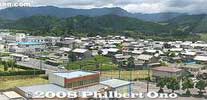
Panoramic view of central Tsuchiyama from Koka City Hall's Tsuchiyama Branch. Route 1 is in the foreground. The old Tokaido Road runs through the houses seen in the middle. The Suzuka mountains are in the far background, beyond which is Mie Pref.90 views
|
|

He skillfully used perspective and made the people on the bridge smaller as they were farther away. Really incredible and meticulous work.90 views
|
|

Page from the Honjin's guest book. Shogun Tokugawa Yoshinobu, the last shogun, also lodged here and signed the guest book. Saigo Takamori also stayed here.89 views
|
|

Bonkei of Ishibe-juku in Koka's neighboring city of Konan. It shows a teahouse which has been reconstructed in Ishibe.88 views
|
|

A mikoshi stands by to be carried during the festival.88 views
|
|

Yuya-machi float has a Little Grebe duck decoration. Little Grebe is Shiga's official bird.87 views
|
|

Honjin guest books signed by all the shoguns, daimyos, and other VIPs who stayed here. All of the guest books since the 17th century have been preserved.86 views
|
|

Bonkei of Otsu-juku. This was the first one Mr. Mikami made. He liked the picture because it included a mochi shop using a famous spring water which his shop (taken over by his son) also used.86 views
|
|

Sankin Kotai: During the Edo Period, all the daimyo lords were required to work alternately between their own fiefs and the capital of Edo (Tokyo). One year at home, and the next year in Edo. Thus, the daimyo had to travel to and from Edo periodically.86 views
|
|

86 views
|
|

Kenketo Odori Dance at Tagi Jinja Shrine in Tsuchiyama, Shiga Prefecture.86 views
|
|

A post town (called shukuba 宿場) was an official rest station for travelers on the Tokaido Road. Inns, teahouses, fresh horses, etc., could be found. This is Koka City Hall's Tsuchiyama Branch on Route 1. There's a lookout deck on the 6th fl.85 views
|
|

85 views
|
|

Prayer in front of the shrine by Tenjin-machi hikiyama float85 views
|
|

Kenketo Odori is a dance performed by eight boys aged 7 to 12. The dance was originally started to ward off calamities. The boys wear tall peacock feathers on their heads. 85 views
|
|

During the festival eve, only one float was displayed at the shrine, while the other floats were open to display in their storehouses.84 views
|
|

Minakuchi Shrine is dedicated to a god named Ominakuchi-sukune-no-Mikoto, the founder of Minakuchi.84 views
|
|
|

What Tokaido Road travelers wore. Their clothing were designed to make it easier to walk. It took a man about 13 days to travel between Edo and Kyoto, and women about 16-18 days.83 views
|
|

Making a turn. This is Higashi-machi hikiyama. 東町83 views
|
|

Hakone bonkei. The elliptical plates are about 50 cm in diameter.82 views
|
|

82 views
|
|

Minakuchi's hikiyama have four wheels and two levels. The wooden construction is complex and the carvings are exquisite.82 views
|
|

Inside the side entrance of the Tsuchiyama-juku Honjin. If you want to see inside the Honjin, call to make reservations. Admission 300 yen. Phone: 0748-66-0007 (English not spoken)81 views
|
|

The Honjin's garden has a stone monument indicating that Emperor Meiji stayed here. It was during the first year of the Meiji Period when he stayed here, and it was in Tsuchiyama when he celebrated his first birthday during the Meiji Period.81 views
|
|

In the same room, you can wear these traveler's costumes and take a picture.81 views
|
|

The hikiyama storehouses line the main streets of Minakuchi. There are 16 hikiyama floats. However, only 6 or 7 of them are paraded on the streets during the festival.81 views
|
|

Readying the paper lanterns to be decorated on the float for the festival eve later in the evening on April 19.81 views
|
|

Tamura Shrine torii gate. The shrine is in northern Tsuchiyama-juku and dedicated to Shogun Sakaue Tamuramaro (758-811) who was famous for subjugating Ezo/Emishi rebels in the northeast Tohoku region.80 views
|
|

Driving on Ozuchi Dam 青土ダム80 views
|
|

Here they come running.80 views
|
|

Tenjin-machi80 views
|
|

80 views
|
|

80 views
|
|

On April 19, ornate floats called hikiyama are taken out of their storehouses and prepared for the festival. 80 views
|
|

Tsuchiyama-juku Honjin is at the center of Tsuchiyama-juku along the old Tokaido Road which meanders along Route 1. Notice the stone monument on the left of the Honjin. 土山宿本陣79 views
|
|

The miniature bonkei sculptures of each Tokaido Road station is based on the respective ukiyoe print. It's an incredible collection, created by Mikami Shizuo 三上静雄, a mochi confection maker in Otsu. He created them during his retirement years.79 views
|
|

The Higashi-machi hikiyama is pulled toward the shrine amid a yae-zakura tree.79 views
|
|
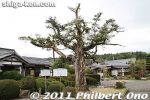
Reiki sacred tree. 霊木79 views
|
|

Traveling between their fiefs and Edo was a great expense. It was one way to keep any daimyo from getting rich enough to finance a rebellion. When they traveled to and from the capital, they lodged at post station towns like Tsuchiyama.78 views
|
|

There he goes, up.78 views
|
|

During the morning of April 20 for the Reitaisai (例大祭) part of the festival, several hikiyama floats proceed to Minakuchi Shrine. This is the Gofuku-machi hikiyama. 呉服町78 views
|
|

78 views
|
|

78 views
|
|

78 views
|
|

Minakuchi Hikiyama Matsuri poster78 views
|
|

Honjin stone marker (reads "Tsuchiyama-juku Honjin ato"). By 1843, Tsuchiyama's population was 1,505. There were two Honjin and 44 inns.77 views
|
|

Food stalls during the festival eve.77 views
|
|

Food and game stalls crowd an adjacent area.76 views
|
|

The entrance is decorated with wooden signs (sekifuda 関札) of the VIPs who stayed here. Whenever a VIP stayed here, the wooden sign with his name on it would be displayed on the gate.75 views
|
|

75 views
|
|

The Tamachi-Katamachi float in Minakuchi Shrine. 田町・片町75 views
|
|

This lists the dates when members of the Imperial Family lodged here. Emperor Meiji came here three times. The first time was on Nov. 3, 1868 when he lodged overnight and celebrated his birthday. The next two times, he only took a break here.74 views
|
|

Model of Tsuchiyama-juku during the 19th century.74 views
|
|

These miniature scenic sculptures are called bonkei (similar to bonsai), created on a plate. He essentially made a 3-D version of each ukiyoe print. It took him 10 years to complete all the 53 Tokaido stations. This one is for Nihonbashi in Tokyo. 盆景74 views
|
|

Next to the Tokaido Tenmakan Museum's main building is the Daimyo Procession Hall which used to be a storehouse.74 views
|
|

Arriving at the Otabisho.74 views
|
|

Hikiyama floats started to appear at Minakuchi Hikiyama Matsuri in 1735. Initially, there were nine floats. This number increased to as many as 30 hikiyama floats.74 views
|
|

74 views
|
|
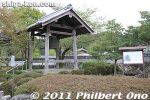
Rakuyaji temple's bell.74 views
|
|

73 views
|
|

The kenketo dancers are put on men's shoulders whenever they are not dancing.73 views
|
|

Then they took a break and most people left. After the break at 4 pm, they danced again at the baba and went to the Otabisho near Yasu River where a ceremony was held. The portable shrines are also carried around. 73 views
|
|

Ukiyoe print of Tsuchiyama-juku by Hiroshige. People at the head of a daimyo procession are crossing a bridge over a river near Tamura Shrine during spring rains. Now see the bonkei in the next photo.73 views
|
|

The Tsuchiyama-juku Honjin opened in 1634 on the occasion of Shogun Tokugawa Iemitsu staying here on his way to Kyoto. The Tsuchiyama family was appointed as the Honjin's caretaker.72 views
|
|

This dirt-floored entryway dates from the Edo Period. It's slightly bumpy and packed hard with a glossy black color. It definitely looks centuries old. Was happy to touch some earth of the Edo Period.72 views
|
|

The Hosokawa daimyo from Kumamoto stayed here quite a few times. When a daimyo was lodging at the Honjin, passers by were required to get off their horses while walking past the Honjin as a gesture of respect.72 views
|
|

Yaku-otoshi Taiko Bridge from where you can "drop" your bad luck below. First buy good luck beans (fuku-mame) from the shrine. Make a wish before dropping the number of beans matching your age into the river below the bridge.72 views
|
|

Inside Tsuchiyama Folk History Museum, mannequins depicting the Kenketo Odori Dance.72 views
|
|

72 views
|
|

72 views
|
|

Near the shrine, the floats stop here to setup the rooftop decorations.72 views
|
|

They knock down the flower umbrella and people rush in to grab something. They repeated this several times. This part of the festival is called Hanabai (花ばい).72 views
|
|
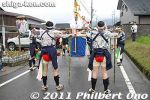
72 views
|
|
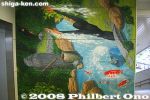
Wall mural sideways, showing ninja and a river.72 views
|
|

To celebrate his birthday, Emperor Meiji gave sake and dried squid to all the families in Tsuchiyama. The Honjin's Tsuchiyama family went to great lengths to prepare for the Imperial stopover. Besides renovating the house, they dug a new water well.71 views
|
|

Diorama of daimyo gyoretsu procession. The daimyo procession is reenacted at some festivals in Japan, such as the Kusatsu Shukuba Festival in Shiga.71 views
|
|

Tongu is the site where the Saio princess lodged on her way to worship from Kyoto to Ise Grand Shrines in Mie Prefecture.71 views
|
|

Matsuo-zaka Slope has this Suzuka Mago (Pack horse) Song Monument. The 10-verse song was sung by pullers of pack horses traveling over Suzuka Pass. It made the phrase "Ai no Tsuchiyama" famous. 鈴鹿馬子唄71 viewsThe first verse reads, "The slope shines, the Suzuka mountains are cloudy. Rain falls on Ai no Tsuchiyama."
The mago horse puller made his living by lending his horse to carry luggage or people. He would sing this song while ringing a bell. The song was very slow and drawn out, with many syllables sung for a few seconds. It was to match the pace of the horse. It has a series of 7 and 5 syllables. The song is one of Japan's most noted pack horse songs and kept alive by a song preservation society and annual song contest in Tsuchiyama.
「坂は照る照る 鈴鹿は曇る あいの土山 雨が降る」
|
|

Stone lantern in Tongu71 views
|
|

A Sugawara Michizane doll waiting to be lifted up on the Tenjin-machi hikiyama float.71 views
|
|

Tenno-cho hikiyama. 天王町71 views
|
|

Tenjin-machi hikiyama float coming through.71 views
|
|

71 views
|
|

71 views
|
|

71 views
|
|

71 views
|
|
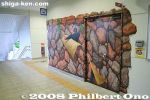
Near the turnstile entrance. These ninja wall murals are called "Trick Art." They look three-dimensional and you can interact with the paintings. You can pose within the painting itself. A brilliant idea. トリックアート71 views
|
|

About the temple's sumo connection.71 views
|
|

Shigaraki Fire Festival: Burned hot and high. It got quite hot even at this distance. I thought my camera would melt.71 views
|
|

The dark stone monument is dedicated to a Chinese-style poem written by Buddhist philosopher Inoue Enryo in 1914 about Emperor Meiji's stay in Tsuchiyama. The monument in the rear indicates that Emperor Meiji stayed or rested in the Honjin.70 views
|
|

Old Tokaido Road in Tsuchiyama-juku. The asphalt is dirt-brown and the houses along the road is a mixture of traditional and modern ones. MAP70 views
|
|

70 views
|
|

70 views
|
|
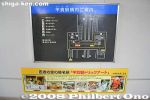
Map of Koka Station and a guide to the "Koka Station Trick Art." Seven wall murals of ninja paintings inside the station.70 views
|
|
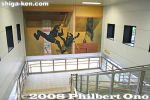
The stairway on the south side of Koka Station has this dramatic mural of ninja in action.70 views
|
|

Kusuri Gakushukan Medicine Museum across from Kafuka Yume no Mori park. 20-min. walk from Koka Station. くすり学習館 MAP70 views
|
|

Shingu Shrine (新宮神社) near Shigaraki Station holds the annual Shigaraki Fire Festival on the fourth Sat. of July closest to July 23.70 viewsIt is a torch procession of 700 people (including children) who carry wooden torches on their shoulders from Shingu Shrine to Atago Shrine on a hill and ending at the parking lot of the Shimin Center.
|
|

A short walk through the long Honjin brought me to the Jodan-no-Ma (Upper Class Room) where the shoguns, daimyo lords, and Emperor Meiji stayed. 上段の間69 views
|
|

Site of the Waki Honjin, used as a secondary Honjin when the Honjin was already occupied. If two daimyo lords were staying in town at the same time, the higher-ranked lord would stay at the Honjin. 脇本陣69 views
|
|

Model of a Toiya-ba which was like a travel logistics office and lodging reservations agency. Staffed by one or more people, it handled horses, messengers, luggage, helpers, etc.69 views
|
|

A toiya-ba staff person keeps records. He might have assigned luggage to fresh horses, gave work to pack-horse pullers, and received arriving travelers and luggage.69 views
|
|

Tokaido Road at Matsuo-zaka Slope. Travelers from Kyoto might have stood here gazing at the difficult Suzuka Mountains ahead. "It's sunny here, but cloudy at Suzuka. In-between, it's raining in Tsuchiyama." The origin of Suzuka Mago-uta?69 views
|
|

All the dolls have different faces. Some of them are even smiling. They are probably happy to have arrived in Tsuchiyama. They must be tired after climbing the Suzuka mountains.69 views
|
|

Stone garden at the Tsuchiyama Tokaido Museum69 views
|
|

The Haiden Hall was undergoing repairs to the foundation when I visited in May 2008.69 views
|
|

"Traverse Road" is painted on the fence.69 views
|
|

"Ai no Tsuchiyama" is a phrase you will see most often. But no one knows for sure what it means. There are numerous theories. "Ai" could mean "in-between," "love," "koi fish," or "soon"...69 viewsPhoto of a display panel at the Tsuchiyama Tokaido Tenmakan Museum.
Entire lyrics of Suzuka Mago-uta song in Japanese:
○坂は照る照る 鈴鹿は曇る あいの土山 雨が降る
○馬がもの言うた 鈴鹿の坂で お参宮上﨟(おさん女郎)なら 乗しょと言うた
○坂の下では 大竹小竹 宿がとりたや 小竹屋に
○手綱片手の 浮雲ぐらし 馬の鼻唄 通り雨
○与作思えば 照る日も曇る 関の小万の 涙雨
○関の小万が 亀山通い 月に雪駄が 二十五足
○関の小万の 米かす音は 一里聞こえて 二里ひびく
○馬は戻(い)んだに お主は見えぬ 関の小万が とめたやら
○昔恋しい 鈴鹿を越えりゃ 関の小万の 声がする
○お伊勢七度 おたがわ八度 関の地蔵は 月参り
|
|

Minakuchi Hikiyama Matsuri festival eve at Minakuchi Shrine on April 19.69 views
|
|

Group photo of Tamachi-Katamachi float.69 views
|
|

69 views
|
|

Woodblock prints which depict Minakuchi.69 views
|
|

Tagi Shrine's closest bus stop is Higashi Maeno. Buses run from Kibukawa Station.69 views
|
|
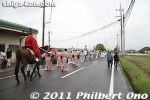
69 views
|
|
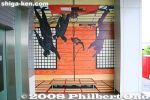
Suspended ninja in a painting next to the elevator. You supposed to sit on the floor and make like the ninja is coming after you.69 views
|
|

They all carry the torches on their shoulders.69 views
|
|

Inside Tokaido Tenmakan Museum. The first floor has a large display case showing a model of Tsuchiyama-juku.68 views
|
|

On the 2nd floor of the Tokaido Tenmakan Museum are two rooms. This one shows kiri-e cut-out pictures of all the Tokaido Road stations.68 views
|
|

Tsuchiyama tea fields in the Tongu area. Koka city produces 80% of the green tea produced in Shiga.68 views
|
|

Poster for the annual Suzuka Mago-uta Song Contest held in Tsuchiyama in June. The picture shows a pack-horse puller (mago) going over Suzuka Pass. The song also mentions Seki-juku in Mie Prefecture where they have a song museum.68 viewsOver 100 contestants sing the same pack-horse puller's song all day long at the Ai no Tsuchiyama Bunka Hall.
|
|

Getting ready for the procession from Minakuchi Shrine to the Otabisho.68 views
|
|

Prayers at the Otabisho.68 views
|
|

Higashi-machi68 views
|
|

68 views
|
|

Tamachi-Katamachi float's flute players. Each float's musicians practice playing the Minakuchi-bayashi festival music every night from late March.68 views
|
|

68 views
|
|

Gofuku-machi68 views
|
|

Pipes68 views
|
|

68 views
|
|
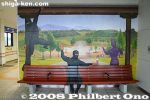
This painting uses a real bench where you can sit down and pose with the ninja. JR Koka Station on the JR Kusatsu Line, Shiga Prefecture.68 views
|
|
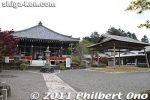
Rakuyaji temple Hondo hall and sumo ring. However, the seated Buddha is behind closed doors, and public viewing is rare. We can only see a picture of it. Photography is not allowed.68 views
|
|

68 views
|
|

Tamura Shrine is in lush woods. Shrine office on left. 田村神社67 views
|
|

Soliciting donations for renovating shrine buildings. Total cost: 200 million yen. To mark the shrine's 1200th anniversary in 2012, they hope to complete large-scale renovations by then.67 views
|
|

Sacred tree67 views
|
|

Ai-no-Oka Bunka Hall where the annual Mago-uta song contest is held.67 views
|
|

Traverse Road has cherry trees. Cherries are a major product of Traverse City.67 views
|
|

Traverse Road, named after Traverse City in Michigan, USA, Tsuchiyama's sister city.67 views
|
|

67 views
|
|

67 views
|
|

67 views
|
|

67 views
|
|

Minakuchi Hikiyama Festival is famous for Minakuchi-bayashi festival music with flutes, taiko drums, and bells. During the festival eve, they play the music in front of their floats in the storehouse. This is Komeya-machi. 米屋町67 views
|
|

Poor guy waiting...67 views
|
|

67 views
|
|

67 views
|
|

Shrine priests give prayers before the procession starts.67 views
|
|

67 views
|
|

Five hikiyama are parked in the shrine.67 views
|
|

The Tamachi-Katamachi float entering Minakuchi Shrine.67 views
|
|

Pipe engraved with "Minakuchi."67 views
|
|

The only part of the castle that looks like a castle is the small, rectangular area (connected by a short bridge) seen on the left side of the map. The large square area on the right is now an athletic/sports ground as you can see in the next picture.67 views
|
|

The first hanagasa went directly to the kenketo dancers. They pulled out the little sticks attached with things like towels, gloves, and maybe some cash.67 views
|
|
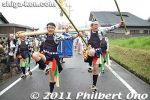
67 views
|
|

The Tsuchiyama-juku Honjin operated until 1870 when the shukuba system was abolished. For over three centuries, the Tsuchiyamas took care of the Honjin. Their 15th-generation descendants live here now and take care of it as a tourist attraction.66 views
|
|

Tsuchiyama-juku on the old Tokaido Road. On the right is the site of the Waki Honjin which is near the Honjin. If no VIPs were staying at the Waki Honjin, ordinary travelers could also stay here if they had the money. This building is not original.66 views
|
|

Site of a Toiya-taku which was the residence of a town official staffing the toiya-ba. This building is not original, not open to the public.66 views
|
|

Model of a pack-horse puller called "mago." He made a living renting his horse to carry luggage and people along the old Tokaido Road. They sang songs like the Suzuka Mago-uta while going over the difficult Suzuka Pass. 馬子66 views
|
|

The daimyo himself travels in a palanquin. These processions helped to develop the towns and roads to and from Edo. It also helped to spread Edo culture to the provinces.66 views
|
|

Tsuchiyama-juku town officials greet the daimyo procession as they arrive. They will lodge at Tsuchiyama.66 views
|
|

Tsuchiyama Folk History Museum (Rekishi Minzoku Shiryokan) 甲賀市土山歴史民俗資料館66 views
|
|

66 views
|
|

Gofuku-machi hikiyama 呉服町66 views
|
|

Kids gathered to caryy their mikoshi portable shrine.66 views
|
|

66 views
|
|

66 views
|
|

Dragon crawling on top of the Tamachi-Katamachi float.66 views
|
|

66 views
|
|

Kenketo dancers, wearing peacock feathers, are carried on shoulders.66 views
|
|

These kenketo dancers got a lot of goodies. They deserve it since they practiced hard for the dance.66 views
|
|

66 views
|
|

66 views
|
|

66 views
|
|

They carried the mikoshi around a few times.66 views
|
|
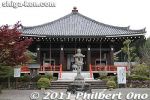
Rakuyaji temple main worship hall. Inside is Japan's largest statue of a seated Kannon Buddha with 11 faces. The Buddha is hidden, shown only once every 33 years. Last shown in fall 2018. 日本最大坐仏十一面観音菩薩 櫟野寺66 views
|
|

Room next to the Jodan-no-Ma. The Honjin has numerous rooms. This is one of the very few original Honjin remaining in Japan. There's another one in Shiga in Kusatsu.65 views
|
|

The Tokaido Tenmakan Museum was the former residence of a farming family who donated the property to Tsuchiyama town. It has a few traditional-style buildings.65 views
|
|

Together with the kiri-e cut-out pictures are each station's famous edible product.65 views
|
|

Inside the Daimyo Procession Hall are about 100 dolls depicting a daimyo procession called the Daimyo Gyoretsu. 大名行列65 views
|
|

Painting on bridge wall65 views
|
|

According to one legend, Shogun Sakanoue Tamuramaro was requested to eliminate mountain bandits robbing travelers on Suzuka Pass. After doing so, he shot an arrow from the top of the Suzuka mountain. The arrow landed here, where bamboo then sprouted.65 views
|
|

Tamachi-Katamachi float65 views
|
|

65 views
|
|

Little Grebe, Shiga's official bird.65 views
|
|

Chigo children65 views
|
|

Each float has a different humanoid decoration called "dashi" (ダシ) on the roof.65 views
|
|

65 views
|
|

65 views
|
|

65 views
|
|

Festival scene at Minakuchi Shrine65 views
|
|

65 views
|
|

Minakuchi Christian Church designed by Vories and built in Nov. 1930.65 views
|
|

Walk a little further east and north to visit the former Minakuchi Public Library designed by William Vories and built in 1928.65 views
|
|

At the Otabisho in Maeno at around 1 pm, they hold a ceremony. Then the Kenketo procession, led by the shrine priest, head for Tagi Shrine. 65 views
|
|

Up they go on human shoulders.65 views
|
|

Kenketo dancers wearing peacock, pheasant and other bird feathers. Their feathered cap is called shagama. シャガマ65 views
|
|

65 views
|
|

They dance again in front of the shrine office. 社務所前で宮踊り65 views
|
|
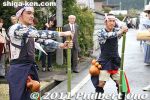
Every few minutes, the Nagamochi yakko-furi unit stops and sings the song as people in the neighborhood come out and watch.65 views
|
|
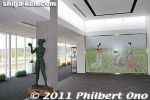
Inside the Kusuri Gakushukan Medicine Museum which is quite new. Phone: 0748-88-8110, Hours: 9:30 am - 5 pm, closed Mon. (open if a national holiday and closed on Tue. instead)65 views
|
|

Toiya-ba stone marker, near the Tokaido Tenmakan Museum. The site is a parking lot now.64 views
|
|

The Tokaido Tenmakan Museum is a local history museum centering on Tsuchiyama and the Tokaido Road. It is near the center of Tsuchiyama, near the Omi-Tsuchiyama bus stop (20 min. from Kibukawa Station via Aikuru bus).64 views
|
|

Tokaido Tenmakan Museum. "Tenma" is Japan's old transportation system using horses to transport people and goods. The museum is a complex of four Japanese-style buildings. 東海道伝馬館64 views
|
|

Monument commemorating famed novelist Mori Ogai's visit to Tsuchiyama in 1900 to visit his grandfather's grave in Jomyoji temple. The grave was later moved to Tsuwano, Shimane Prefecture.64 views
|
|

Inside Tokaido Tenmakan Museum64 views
|
|

In the other room on the 2nd floor is a large space, like an attic. It displays ukiyoe prints and miniature scenic sculptures (bonkei) of all the 53 Tokaido post town stations.64 views
|
|

The dolls were special ordered from Kyoto.64 views
|
|

Way to Tamura Shrine's Honden Main Hall. Stone lanterns are donated by parishioners.64 views
|
|

Gofuku-machi64 views
|
|

After the prayer, they pull the float to its place within the shrine.64 views
|
|

Decoration on Gofuku-machi hikiyama 呉服町64 views
|
|

64 views
|
|

64 views
|
|

64 views
|
|

The floats arrive one after another. This is the Tenno-cho hikiyama. 天王町64 views
|
|

Higashi-machi64 views
|
|

Tamachi-Katamachi float64 views
|
|

Putting up the rear tapestry.64 views
|
|

This plaque shows a woodblock print by Hiroshige depicting Minakuchi-juku. (A clearer image of this print is shown below.)64 views
|
|

This is the rock which Tokugawa Ieyasu sat on when he visited the temple in May 1600. He sat on it while talking to the temple priest. Anyone can now sit on it. Called Tokugawa Ieyasu koshi-kake ishi. It was moved here in 1900. 腰掛石64 views
|
|

Near the forked intersection is Daitokuji Temple. Originally a Zen temple, it now belongs to the Jodo-shu sect. When Tokugawa Ieyasu passed through and visited the temple, he renamed it Daitokuji. 大徳寺64 views
|
|

Another intersection.64 views
|
|

Minakuchi Castle Museum is open 10 am to 4 pm, closed on Thursday and Fri. 水口城資料館64 views
|
|

Path to the shrine. The shrine is in Maeno in Tsuchiyama. MAP64 viewsThis Kenketo Odori Dance has been inscribed as a UNESCO Intangible Cultural Heritage in 2022 as one of Japan's furyu-odori (風流踊) ritual dances.
|
|

Large sacred tree.64 views
|
|

64 views
|
|

64 views
|
|

64 views
|
|

64 views
|
|
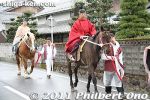
Shrine priest on horseback.64 views
|
|
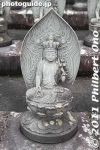
64 views
|
|

A few videos about Tsuchiyama and the Tokaido can be viewed.63 views
|
|

Tea leaves63 views
|
|

They are replacing the foundation and foot of the columns.63 views
|
|

63 views
|
|

Yuya-machi hikiyama 湯屋町63 views
|
|

63 views
|
|

63 views
|
|

Here comes Higashi-machi hikiyama making a wide and grand entrance to the shrine.63 views
|
|

Momotaro decoration on the Tenno-cho hikiyama. 天王町63 views
|
|

63 views
|
|

This is the site of Minakuchi-juku's Toiyaba which was like a travel logistics office and lodging reservations agency. Staffed by one or more people, it handled horses, messengers, luggage, helpers, etc. 問屋場63 views
|
|

It's a real frenzy. I managed to pick up a plastic flower.63 views
|
|

Kenketo dancers dancing around Tagi Daimyojin-no-Miya Shrine.63 views
|
|

63 views
|
|

63 views
|
|

Festival spectators63 views
|
|

63 views
|
|
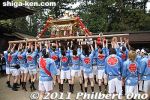
63 views
|
|

63 views
|
|
| 1139 files on 5 page(s) |
 |
3 |  |
|